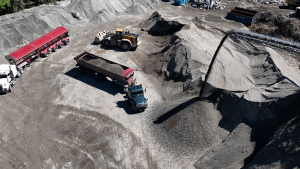What if you could reduce your project’s greenhouse gas emissions and target financial rebates with the same program?
That was the goal when Alberta-based Mavryck Inc. and Ontario’s Mohawk College partnered to create VivClima, a new artificial-intelligence-based construction project management software designed to help companies make emission baselines and reduce their carbon footprint.
“We are using machine learning from a neural network. We have designed algorithms which take information like how much and what type of equipment will be deployed or how much concrete will be poured for a project,” said Mavryck founder and CEO Munir Khan.
“What it does is it calculates the whole greenhouse emission by stages of the project, starting from the source until the execution.”
Khan studied AI at the Massachusetts Institute of Technology before pivoting his company into the sector in 2018, he said.
VivClima essentially calculates all the operational emissions for a project, from planning to final construction. It provides recommendations and simulated scenarios to help companies understand how what they’re doing affects emissions and what they could be doing differently.
It can help you build to reduce your carbon emissions and also get tax rebates from the government,
— Munir Khan
Mavryck founder and CEO
“It also flags early warnings that if you continue along a certain trend then this is what your emissions will be like based on an approximate value,” he said.
The software is also made to help companies find tax savings and financial rebates through emission reductions.
“If you are looking into rebates and you need to do something from an offset point of view, we have built this powerful recommendation engine which makes recommendations based on certain emitting activities,” he said.
“It can help you build to reduce your carbon emissions and also get tax rebates from the government.”
Emily Vis, project lead at Mohawk College, said the financial benefits of the software were a core focus in development.
“There’s significant increases over the next few years with the Canadian Carbon Tax that’s going to require a little more analysis of where emissions come from,” Vis said.
“We’re trying to proactively prepare construction companies for upcoming legislation and potential price savings through emission reductions. We’re giving them the information they need to make those financial business decisions.”
The software can calculate emissions ranging from how long a jackhammer is used onsite to how long the lights are left on in an office, ensuring it covers all the stages of a project.
It is designed to include Canadian locality into the equation.
“For example, if you are using electricity in Ontario the emissions associated with turning your light on for eight hours a day is a lot less than in Alberta or Nova Scotia because of the source of the electricity in a specific location,” she said.
One of the benefits of using AI is that VivClima can analyze emissions data faster than a human worker could ever hope to.
“It’s a lot quicker, it’s a lot less effort and its more accurate,” said Vis.
The software allows users to run “what if” scenarios, said Khan, to enable a comprehensive understanding of how using different equipment, different fuel sources and operating in different areas can directly affect GHG emissions.
“There’ll be a slider scale, like if a company wants to reduce a particular emitting activity it will show what the overall emissions calculation will look like and provide recommendations than can be turned into actionable items.”
The AI was trained on more than 250 construction projects throughout Canada and its knowledge base will continue to grow, he said.
VivClima also creates a historical record of any projects it works on, allowing companies to view past projects and create exact emission baselines and comparisons, said Khan.
“Our software does the heavy lifting such as data cleansing, data combining ― everything is done by the system. We give that back to the project managers who can then advocate based on facts and figures the types of decisions they should be making to change the course of their project.”
Vis said seeing AI and environmentalism merge in VivClima was an important step forward in the climate fight.
“Most environmentalists that work in the field do not have a strong computing or software development background,” she said.
“To successfully marry those two worlds and then hopefully work to reduce the actual requirements and the manual demand for people is very exciting.”
The software was developed by Mavryck while Mohawk brought the environmental expertise through its applied research centres; the Centre for Climate Change Management and the Energy & Power Innovation Centre.
Khan says the software can only grow from here and is already working with international companies to bring its use beyond Canadian borders.
Follow the author on Twitter @JOC_Evan.











Recent Comments
comments for this post are closed